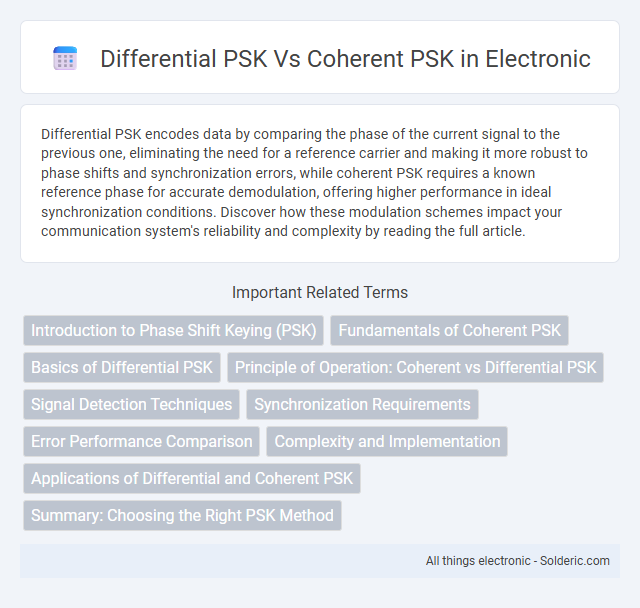Differential PSK encodes data by comparing the phase of the current signal to the previous one, eliminating the need for a reference carrier and making it more robust to phase shifts and synchronization errors, while coherent PSK requires a known reference phase for accurate demodulation, offering higher performance in ideal synchronization conditions. Discover how these modulation schemes impact your communication system's reliability and complexity by reading the full article.
Comparison Table
| Feature | Differential PSK (DPSK) | Coherent PSK |
|---|---|---|
| Detection Method | Non-coherent, compares phase difference between symbols | Coherent, requires exact carrier phase reference |
| Complexity | Lower complexity, no carrier synchronization needed | Higher complexity due to phase synchronization |
| Performance (BER) | Higher Bit Error Rate (BER) compared to coherent PSK | Lower BER, better noise immunity |
| Implementation Cost | Cost-effective, simpler receiver design | More expensive, requires phase-locked loop or equivalent |
| Phase Ambiguity | Resistant to phase ambiguity | Susceptible to phase ambiguities, requires resolved carrier phase |
| Applications | Used in systems where phase synchronization is difficult (e.g., mobile, satellite) | Used in high-performance communications with stable carrier phase |
Introduction to Phase Shift Keying (PSK)
Phase Shift Keying (PSK) modulates data by varying the phase of a carrier signal, with coherent PSK requiring phase synchronization between transmitter and receiver for accurate demodulation. Differential PSK transmits data based on phase differences between successive signals, eliminating the need for exact phase reference and simplifying receiver design. Your choice between differential and coherent PSK affects system complexity, sensitivity to noise, and synchronization requirements.
Fundamentals of Coherent PSK
Coherent PSK requires a reference carrier signal that is synchronized in phase and frequency at the receiver, enabling accurate phase detection of the received signal. This synchronization allows for higher signal-to-noise ratio performance and improved bit error rate compared to differential PSK. Precise carrier recovery techniques, such as phase-locked loops, are essential to maintain coherence and ensure reliable demodulation in coherent PSK systems.
Basics of Differential PSK
Differential Phase Shift Keying (DPSK) encodes data by comparing the phase of the current signal with the previous one, eliminating the need for a coherent reference signal. This method enhances robustness against phase ambiguity and reduces complexity in receiver design by avoiding explicit phase synchronization. DPSK is particularly advantageous in environments with rapid phase variations or where maintaining carrier phase coherence is challenging.
Principle of Operation: Coherent vs Differential PSK
Coherent PSK relies on precise phase reference synchronization between the transmitter and receiver, enabling accurate phase detection by comparing the received signal with a locally generated reference. Differential PSK encodes data based on phase changes between successive symbols, eliminating the need for a coherent reference and allowing simpler, more robust demodulation in noisy or fading channels. Your choice depends on system complexity and channel conditions, with coherent PSK offering better performance under stable synchronization and differential PSK providing resilience against phase ambiguity.
Signal Detection Techniques
Differential PSK (DPSK) utilizes phase difference between consecutive signals for detection, eliminating the need for a coherent reference signal and simplifying receiver design. Coherent PSK requires an accurate phase reference for demodulation, enabling optimal detection performance but increasing receiver complexity. Your choice between DPSK and coherent PSK will depend on the trade-off between implementation complexity and detection accuracy in your communication system.
Synchronization Requirements
Differential PSK (DPSK) eliminates the need for explicit carrier phase synchronization by encoding data through phase differences between consecutive symbols, greatly simplifying receiver design. Coherent PSK requires precise carrier phase synchronization using phase-locked loops or pilot signals to correctly demodulate the phase of each symbol. The synchronization overhead in coherent PSK increases system complexity and power consumption, while DPSK tolerates phase offsets and is more resilient in rapidly varying channels.
Error Performance Comparison
Differential PSK (DPSK) exhibits a higher error rate compared to coherent PSK due to its reliance on phase difference detection rather than absolute phase, which makes it more susceptible to noise and phase ambiguity. Coherent PSK benefits from accurate carrier phase synchronization, enabling lower bit error rates and improved performance in low signal-to-noise ratio (SNR) environments. Your communication system's error performance can be significantly enhanced by choosing coherent PSK when precise phase tracking is feasible.
Complexity and Implementation
Differential PSK (DPSK) offers reduced receiver complexity by eliminating the need for exact carrier phase synchronization, simplifying implementation in environments with phase noise or rapid channel variations. Coherent PSK requires precise phase reference recovery, demanding complex phase-locked loops and higher computational resources, which increases system complexity and power consumption. Your choice between DPSK and coherent PSK impacts hardware design and signal processing requirements, balancing ease of implementation against potential performance gains.
Applications of Differential and Coherent PSK
Differential PSK (DPSK) is commonly used in wireless communication systems where rapid phase changes make coherent detection challenging, such as in mobile radio and satellite communications, due to its robustness against phase noise and less complex receiver design. Coherent PSK, relying on carrier phase synchronization, is preferred in applications demanding higher sensitivity and performance, like optical fiber communication and radar systems, offering improved bit error rates through precise signal detection. Your choice between Differential and Coherent PSK depends on system complexity, performance requirements, and environmental conditions impacting phase stability.
Summary: Choosing the Right PSK Method
Differential PSK (DPSK) eliminates the need for a coherent reference signal by encoding information in the phase difference between consecutive symbols, making it more robust in environments with phase noise or rapid phase variations. Coherent PSK, however, uses a reference signal for precise phase detection, offering higher spectral efficiency and better performance in stable, low-noise channels. Your choice depends on system complexity, channel conditions, and performance requirements, with DPSK suited for simpler, noisy scenarios and coherent PSK ideal for high-precision communication systems.
differential PSK vs coherent PSK Infographic

 solderic.com
solderic.com